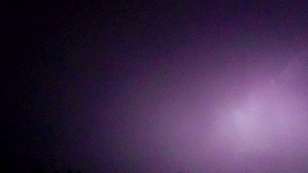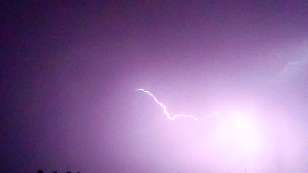Rick's b.log - 2015/08/13
You are 3.133.137.201, pleased to meet you!
Rick's b.log - 2015/08/13 |
|
| It is the 18th of December 2024 You are 3.133.137.201, pleased to meet you! |
|
mailto: blog -at- heyrick -dot- eu
I learned that a mobile phone sucks for recording lightning. Its camera was swamped by the flash of intense brightness so the end result was a rolling picture that didn't show much of anything.
This should have been good...
But, don't worry. I had another camera that I could dig out once the torrential rain had passed. This camera, a much better imager, gave me a great view of the formation of a bolt of lightning. Here, across the next twenty frames, is the formation of the lightning. The camera records at 30fps, so 20 frames would be 2/3rds of a second, or 3.3cs between each image.
An interesting observation is the high level of graininess in frame 16. I had originally thought it was a momentary AGC fail following two bright frames, but we've already had something similar (frame 9). I wondered if it was a low level form of EMP, and if we can consider frames 14 and 15 to be the main strike, then not only will there have been an EMP pulse (this can damage phone systems and the like even though there is no direct strike due to induction), there will also have been a burst of X-rays (and other forms of low-level radiation). Given this, it may be possible that the telephone didn't suffer an AGC issue alone, it may have been smacked by EMP/X-rays; and I think one can be certain that a 1.4GHz smartphone is likely to suffer more than a digital camera that probably runs the image encoding on a DSP attached to a much slower processor...
Thunder and lightning
Had a nasty storm last night.

(the black part at the bottom is where the image rolled and stopped)
Frame 1; after 0 cs
Frame 2; after 3.3 cs
Frame 3; after 6.6 cs
Frame 4; after 9.9 cs (tenth second)
Frame 5; after 13.2 cs
Frame 6; after 16.5 cs
Frame 7; after 19.8 cs
Frame 8; after 23.1 cs
Frame 9; after 26.4 cs (quarter second)
Frame 10; after 29.7 cs
Frame 11; after 33 cs (third second)
Frame 12; after 36.3 cs
Frame 13; after 39.6 cs
Frame 14; after 42.9 cs
Frame 15; after 46.2 cs
Frame 16; after 49.5 cs (half second)
Frame 17; after 52.8 cs
Frame 18; after 56.1 cs
Frame 19; after 59.4 cs
Frame 20; after 62.7 cs
Anyway, something to consider.
No comments yet...
| © 2015 Rick Murray |
This web page is licenced for your personal, private, non-commercial use only. No automated processing by advertising systems is permitted. RIPA notice: No consent is given for interception of page transmission. |